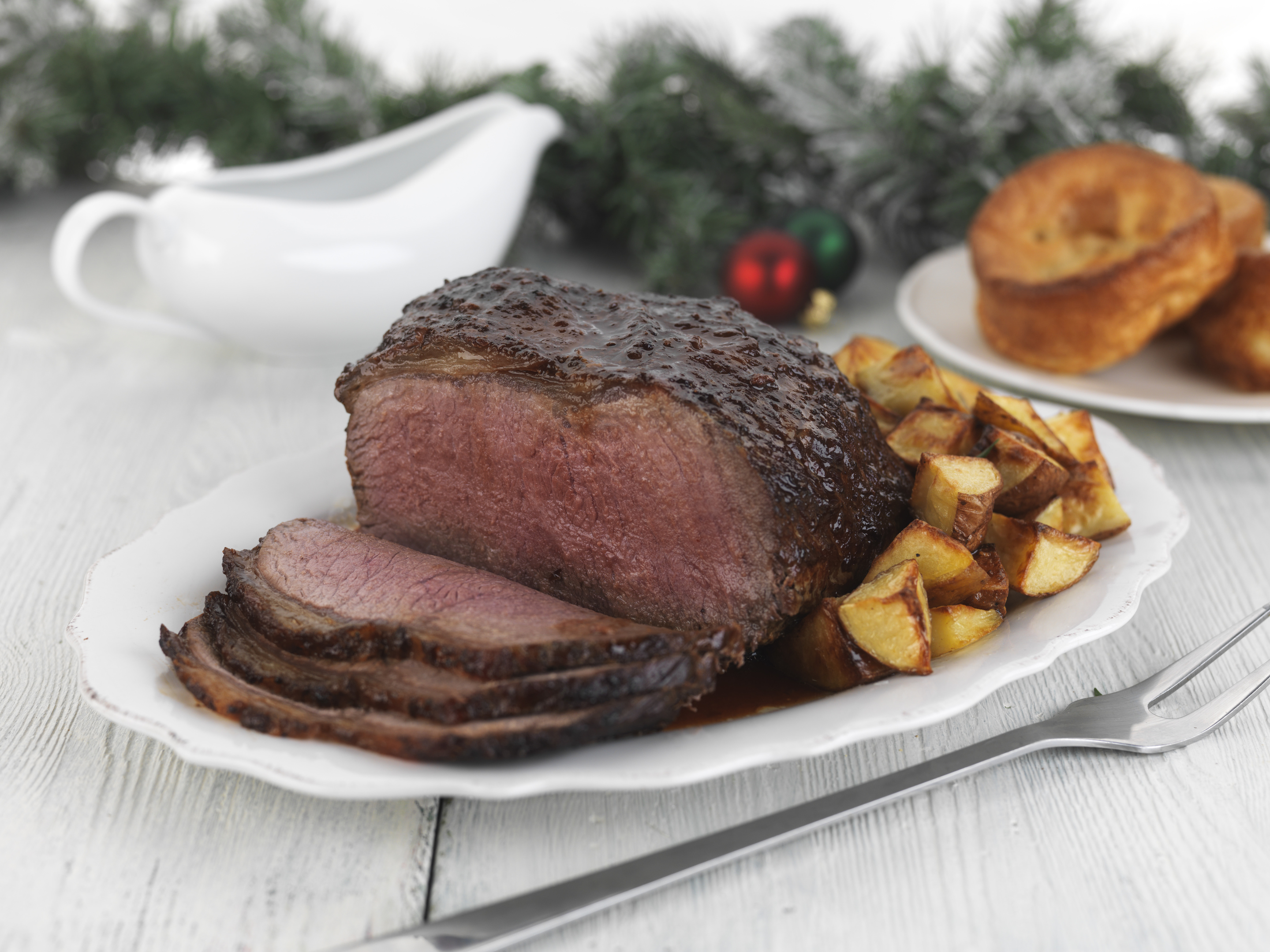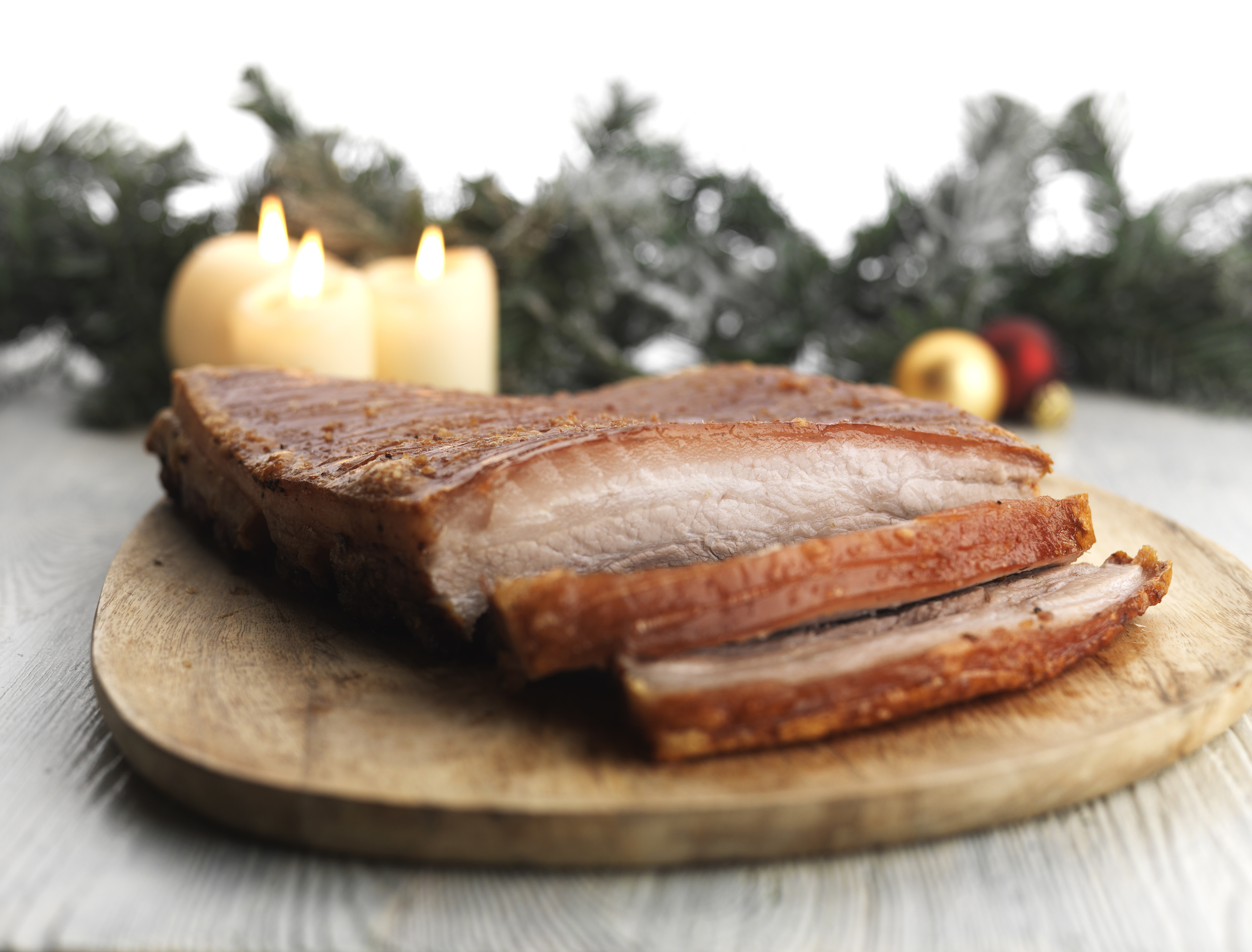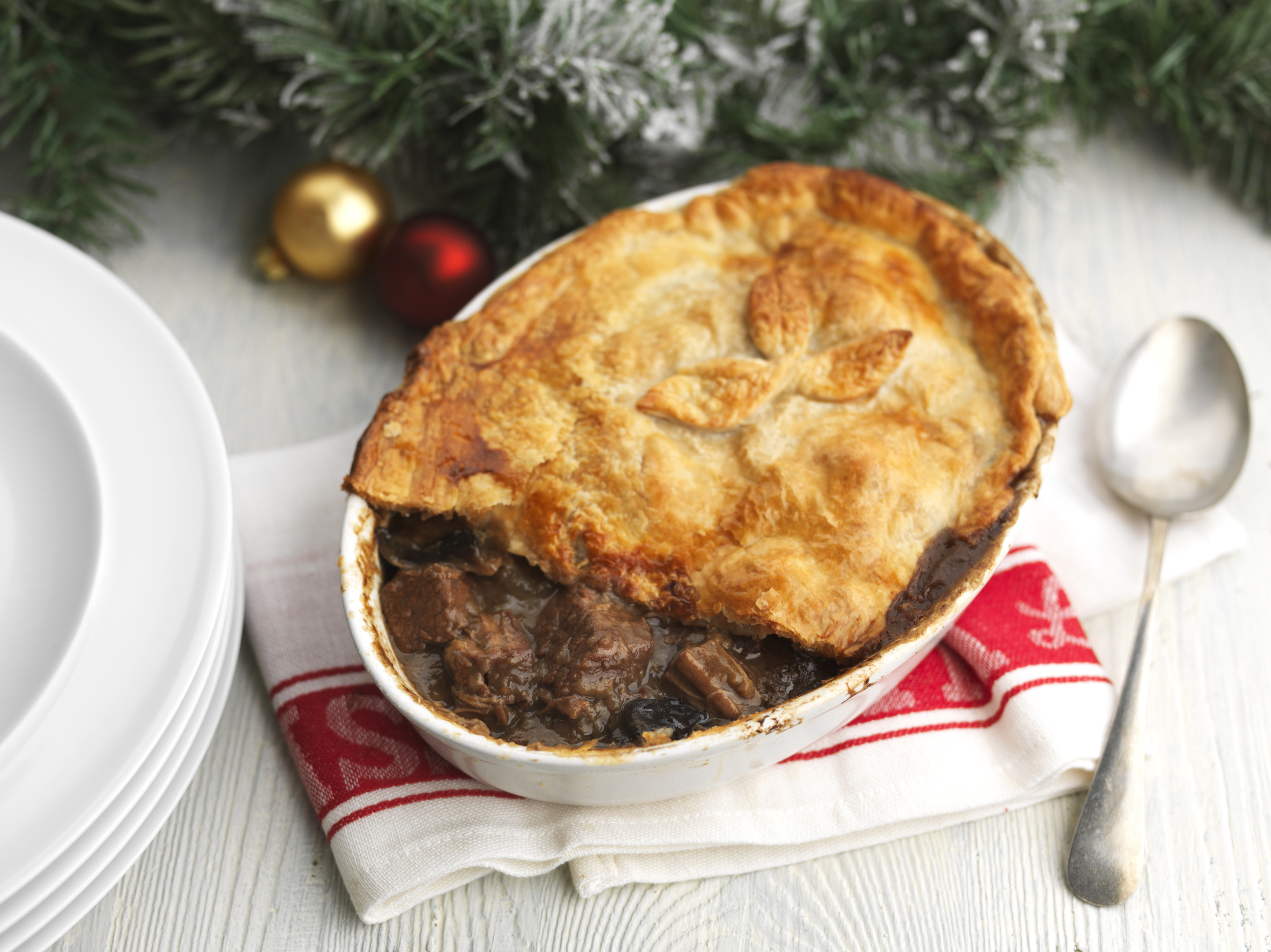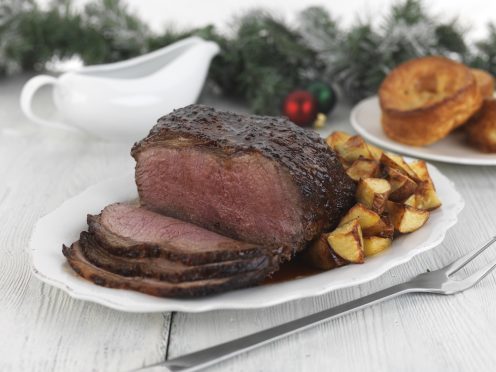Welcome in the New Year with a celebratory lunch
or dinner featuring these warming, flavour-packed
dishes from Quality Meat Scotland.
ROAST RIB OF SCOTCH BEEF WITH CRANBERRY, PORT & ROASTED GARLIC GLAZE

SERVES SIX
Allow 100-175g (4-6oz) of raw meat per person for boneless joints and 225-350g (8-12oz) for bone-in joints
Lean boned and rolled Scotch Beef sirloin joint (rib or topside joints could also be used)
900g potatoes
3 red onions
8-10 garlic cloves
Oil
150ml port
60ml cranberry sauce
15-39ml gravy granules
Take a lean, boned and rolled Scotch Beef sirloin joint and calculate the cooking time using the timings below. Place onto a rack in a roasting tin and open roast in a pre-heated oven for calculated cooking time.
Gas mark 4-5, 180C, 350F. Rare, 20 minutes per 450g/.5kg (1lb) plus 20 minutes. Medium, 25 minutes per 450g/.5kg (1lb) plus 25 minutes. Well done, 30 minutes per 450g/.5kg (1lb) plus 30 minutes.
50-60 minutes before the end of cooking time add 900g (2lb) potatoes, peeled and cut into large chunks (this quantity would serve about six), three red onions halved and 8-10 garlic cloves to the roasting tin and drizzle with 15ml (1tbsp) oil. After 30 minutes remove the garlic cloves.
In a saucepan, place 150ml (quarter of a pint) port and 60ml (4tbsp) cranberry sauce. Squeeze the roasted garlic cloves out of their skins and add to the saucepan. Heat for five minutes until the cranberry sauce has melted.
20 minutes before the end of cooking time glaze the joint with a couple of spoonfuls of the glaze. Repeat during the last 10 minutes.
When the joint is cooked, remove from the roasting tin and add 300ml (half a pint) water or stock to the pan, stirring to remove any crispy bits. Add to the saucepan with any remaining glaze, bring to the boil and add 15-30ml (1-2tbsp) gravy granules, heat for one to two minutes until thickened.
Serve the Scotch Beef with roasted potatoes, Yorkshire puddings, seasonal green vegetables and gravy and enjoy.
SLOW ROAST SPECIALLY SELECTED PORK BELLY

SERVES 6-8
FOR THE PORK
2kg piece of Specially Selected Pork belly (ask for the end with fewer bones, to make carving easier)
2 tsp salt
FOR THE PASTE
2 cloves garlic
1tsp salt
2tsp fennel seeds (or dried rosemary)
Preparation Time: 10 minutes. Cooking time: three to three and a half hours.
Preheat the oven to 220 C/180C fan/gas 7.
Peel the garlic and crush all the ingredients for the paste together in a pestle and mortar. Use the end of a rolling-pin if you don’t have one.
Place the pork skin-side down on a board and trim away any excess fat from the underside. With a sharp knife, slash the flesh quite lightly in a criss-cross pattern. Rub the garlic paste well into the cuts and all over the meat’s surface.
Turn the pork belly skin-side up again on the board and rub the salt well into the skin, making sure it comes into contact with the fat layer to ensure good crisp crackling.
Place the pork on a wire rack within a large roasting tin to allow the fat to run away from the meat during the slow cooking process.
Roast in the hot oven for 30 minutes to get the crackling going and then reduce the oven temperature to 160C/140C fan/gas 2 for a further two and a half to three hours.
Serve hot or cold.
STEAK AND MUSHROOM PIE

SERVES 8
Preparation time: 90 minutes (plus cooling time). Cooking time: 60 minutes.
FOR THE PIE FILLING
20g dried mixed wild mushrooms
1.5kg Scotch Beef braising steak
3tbsp plain flour
3tbsp vegetable oil
3 medium onions
6-8 large flat mushrooms
1 litre hot beef stock (made from cubes if you wish)
3 sprigs thyme
1 bay leaf
FOR THE TOPPING
500g ready-made puff pastry
1 small egg
In a small bowl, cover the dried mushrooms with 200ml boiling water and set aside to soak.
Peel and thickly slice the onions. Heat some of the vegetable oil in a deep pan and gently fry the onions for 5-10 minutes until softened. Transfer softened onions to an oven-proof casserole with a slotted spoon.
Cut the Scotch Beef braising steak into 3cm cubes and season the plain flour with salt and pepper. Toss the beef in the seasoned flour, shake off any excess then fry in the remaining oil until well browned. This is best done in batches, using oil as necessary.
Pour the beef stock and the mushroom soaking liquid into the pan and stir to gather up all the sticky bits from the bottom. Pour this mixture over the beef in the casserole dish along with the soaked mushrooms, thyme and bay leaf. Bring to the boil then cover with a lid and cook in the oven for about one and a quarter hours, or until the meat is tender. Adjust the seasoning if necessary.
Quarter the flat mushrooms and lightly sauté in a little oil. Set aside until the meat is cooked. Stir the mushrooms into the meat mixture then spoon it into a two-litre traditional pie dish, with only a minimum of the gravy, and allow the meat to cool completely.
If the gravy is a little thin, set the casserole over a medium heat, bring back to the boil then simmer for 5-10 minutes without the lid, allowing the gravy to reduce and thicken. Spoon some of this into the pie dish to just sufficiently coat the meat and reserve the rest to serve with the pie.
When the meat is cool, set the oven to 200C/180C fan/gas 6.
Roll out the pastry to the thickness of a pound coin (3-4mm) and cut two strips to stick to the thumb-rim of the pie dish. Stick the strips by wetting the rim with water and placing on the pastry.
Cover the whole dish with pastry, moistening the base pastry first, and press to seal all round with the side if your thumb.
Trim off any excess pastry and use to decorate the top of the pie. Beat the egg and lightly brush the pastry. Pierce a hole in the top with a sharp knife, to allow steam to escape, then set to cook for about 50 minutes until the pastry is nicely risen and golden brown, and the filling piping hot.
Reduce the oven temperature to 180/160 fan/gas 4 after the first 15-20 minutes cooking. If you feel the pastry is browning too quickly, cover the pie loosely with a double sheet of baking parchment.
Serve with lightly buttered steamed cabbage and the reserved gravy.
Quality Meat Scotland (QMS) is the government body which looks to promote Scotch Beef, Scotch Lamb and Specially Selected Pork. For further information or more recipe ideas visit www.qmscotland.co.uk
